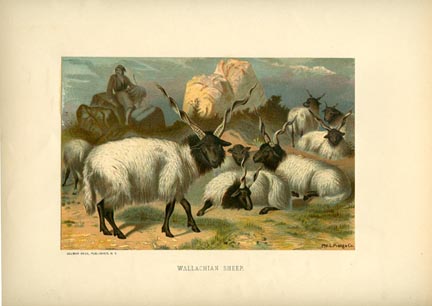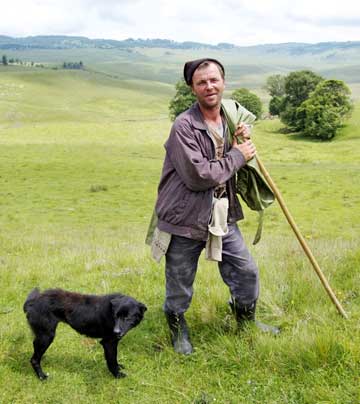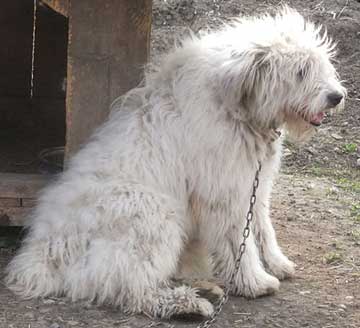

![]()
HERDING DOGS OF EASTERN EUROPE
THE HERDING DOGS OF ROMANIA
Above, a painting of Romanian Wallachian Sheep.
(Artist unknown, printed in the 19th century
by Louis Prang and Company, in the public domain.)
 Left, a photo of a Romanian shepherd and his dog from the Oas-Gutai Plateau in the mountainous Maramures region of Rumania. (Photograph taken in 2009 by Toomas Kokovkin and reprinted with permission.)
Left, a photo of a Romanian shepherd and his dog from the Oas-Gutai Plateau in the mountainous Maramures region of Rumania. (Photograph taken in 2009 by Toomas Kokovkin and reprinted with permission.)
The Carpathian Mountains form an arc more than 1500 km long across Central and Eastern Europe. More than half the range lies in Romania, with a portion in southwest Ukraine, southern Poland, northern Hungary, Slovakia and the Czech Republic. Half of Romanian livestock are still grazed in the Carpathian and Transylvanian mountains each summer. Many of the smaller flocks are combined into groups of three to five hundred sheep with hired shepherds to accompany the flocks. In the winter, some sheep are housed, but others spend the winter penned outdoors. The farmers own livestock guardian dogs (LGDs) and maybe a herding dog or two. Both LGDs and herding dogs that accompany the flocks to the mountains in summer are usually owned by the hired shepherds.
Like all the regions of Eastern Europe, Romania has a complicated history that includes wave upon wave of conquerors and settlers from other parts of Europe and Asia. With regard to a possible shepherd's dog, the one group of interest might be the Cumans from Southern Russia. We saw them before in Hungary in relation to the Komondor dog. These nomadic pastoralists also invaded a portion of Romania known as Wallachia in the early 11th century. It is thought that they brought with them flocks of exotic-looking sheep, today called Wallenschaf or Walanchian. These sheep are white with black head and legs, and long twisted horns. In Hungary, there is a similar sheep breed is called the Racka. The Walachian are an endangered landrace breed in Romania. Nevertheless, Romania still has large flocks of indigenous sheep. Many of the flocks are transhumant, kept for milk products, wool, skins and meat. According to the Romanian Ministry of Agriculture, "in the traditional production systems the flock of some 300-500 sheep, directed by shepherd and dogs, grazed as long as possible on high mountain...pasture[s] or around the villages..."
 Left, an all-white Romanian Mioritic chained to a doghouse in Romania. (Photo from Wikipedia by Dorin Rodina and reprinted under the Creative Commons Attribution-Share Alike 2.0 Generic license.)
Left, an all-white Romanian Mioritic chained to a doghouse in Romania. (Photo from Wikipedia by Dorin Rodina and reprinted under the Creative Commons Attribution-Share Alike 2.0 Generic license.)
The Cumans' may have also brought with them their Komondor dogs. These dogs would have bred with the local dogs and undoubtedy contributed their genes to the Romanian LGDs. Romania has four breeds of indigenous sheepdogs, but they are all of the large, molosser-type breeds. One of these, the Ciobanesc Românesc Mioritic is a dog much like the South Russian Ovcharka and may have been used for both herding and guarding at some point. It resembles a large OES or Bearded Collie. The other three are molosser-type dogs. In general, these dogs accompany the flocks on their migrations and protect the sheep from predation, most notably from wolves and bears, but also from other dogs. During the Communist regime, people were forcibly settled in cities, abandoning their dogs, so packs of feral dogs are a big problem for Romanian shepherds.
Do the shepherds in Romania also use herding dogs today, and if so, what breeds or types? Several photos I have seen show Romanian shepherds wearing traditional, long sheepskin cloaks, with small, black, curly-haired sheepdogs with pointed ears, similar to the Croatian Sheepdog or the Hungarian Mudi. The photo (top left) shows a black dog with a smooth coat. This type may be similar to the Hungarian Sinka. A film made of sheep herding in Romania, shows the shepherd, in traditional clothes, with a similar type of dog.
Copyright © 2014 by Carole L. Presberg
Resources:
Kokovkin, Toomas. An Estonian photographer who specializes in human cultures, capturing everyday lives of rural and coastal people. Mr. Kokovkin has an extensive photography website (http://toomas.photoshelter.com/).
Langa, Nick. Film, "Following the Shepherd's Star", 2006 Bruce Garrison Enterprises (www.cultureunplugged.com/play/3675/Following-the-Shepherd-s-Star).
Romanian Ministry of Agriculture, Forestry and Environment. "Romanian Strategy for a Sustainable Management of Farm Animal Genetic Resources", 2003.
Wallach, Mike. "Wallachian Sheep", 2004-2006 (www.netsnake.com/wallachs/wallachia/sheep.html)
Wikipedia: "Agriculture in Romania" (http://en.wikipedia.org/wiki/Agriculture_in_Romania).
Wikipedia: "Romania" (http://en.wikipedia.org/wiki/Romania).
Wikipedia: "Romanian Mioritic Shepherd Dog" (http://en.wikipedia.org/wiki/Romanian_Mioritic_Shepherd_Dog).
Return to
![]()
BORDER COLLIE COUSINS
THE OTHER WEB PAGES WE MAINTAIN
These web pages are copyright ©2014
and maintained by webmeistress Carole Presberg
with technical help from webwizard David Presberg
ALL RIGHTS RESERVED
If you are interested in using ANY material on this website, you MUST first ask for permission.